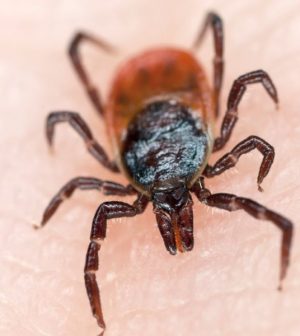- Navigating Your Midlife Crisis: Embracing New Possibilities
- City Raccoons Showing Signs of Domestication
- Mapping the Exposome: Science Broadens Focus to Environmental Disease Triggers
- One Week Less on Social Media Linked to Better Mental Health
- Your Brain Changes in Stages as You Age, Study Finds
- Some Suicide Victims Show No Typical Warning Signs, Study Finds
- ByHeart Formula Faces Lawsuits After Babies Sickened With Botulism
- Switch to Vegan Diet Could Cut Your Greenhouse Gas Emissions in Half
- Regular Bedtime Does Wonders for Blood Pressure
- Dining Alone Could Mean Worse Nutrition for Seniors
To Repel Ticks This Summer, Try Insecticide-Treated Clothes

Outdoor enthusiasts: Here’s a bit of good tick-fighting news just in time for Memorial Day weekend and the unofficial start of summer.
A new U.S. government study confirms that insecticide-treated clothes marketed for preventing tick-borne ills do, in fact, thwart the pests.
In lab tests of clothes bought from one manufacturer, researchers found that the garments either quickly caused ticks to fall off, or rendered them unable to bite.
The study involved three types of ticks that, in the United States, are major carriers of disease — including Lyme disease, Rocky Mountain spotted fever, and what’s known as southern tick-associated rash illness, or STARI.
The clothes were pretreated with permethrin, a synthetic form of an insect-thwarting compound from the chrysanthemum flower. It’s used in insecticide sprays and shampoos and creams that treat lice and scabies.
Several companies already market permethrin-treated shirts, pants, socks and other clothing, as a way to ward off disease-transmitting pests. The new study adds to evidence that the garments are indeed toxic to ticks, according to senior researcher Lars Eisen, of the U.S. Centers for Disease Control and Prevention.
“All tested tick species and life stages experienced the ‘hot-foot’ effect after coming into contact with permethrin-treated clothing,” Eisen said.
That, he explained, made the ticks drop off of “vertically oriented” clothes — which would simulate a pair of pants when a person is standing.
In addition, Eisen said, when the ticks were in contact with the clothes for up to five minutes, they lost their ability to move normally — and to bite.
There are still questions, he noted, including what types of clothing offer the best protection in the real world.
The CDC already recommends permethrin as one tactic for avoiding tick bites. It says that people can “treat clothing and gear, such as boots, pants, socks and tents, with products containing 0.5 percent permethrin.”
The agency further says that “pretreated clothing is available and may be protective longer.”
Thomas Mather is director of the University of Rhode Island’s Center for Vector-Borne Disease and its TickEncounter Resource Center.
He said the new findings, published May 24 in the Journal of Medical Entomology, offer more support for the tick-fighting garments.
“This can be a pretty effective way to stop ticks,” said Mather, who was not involved in the study.
In his own research, Mather found there are benefits even with permethrin-treated summer clothes that leave some skin uncovered — shorts, T-shirts, socks and sneakers.
His team had a group of brave volunteers watch a movie while allowing lab-raised, disease-free ticks to crawl on their bodies. Some wore regular clothes, some wore clothes with permethrin — either pretreated or with the insecticide added using home kits. Those wearing either kind of treated clothing ended up with far fewer live ticks on their bodies by the end of the movie.
While people can use permethrin on their regular clothes, the pretreated garments hold up to many more washings, according to Mather — up to 70.
Some people may be wary of chemically treated clothes. But, Mather said, the amount of permethrin in clothing is very low: A solution containing only 0.5 percent of the pesticide is “dried into” the fabric.
According to the U.S. Environmental Protection Agency, research indicates that permethrin is “poorly absorbed” through the skin, and there’s no evidence that treated clothing could be harmful to children or pregnant women.
U.S. military members have been using permethrin-treated uniforms since the 1990s, the EPA noted. According to Mather, the garments may also be a good bet for people whose jobs keep them outdoors — or for gardeners or anyone else who spends time in places where tick exposure is a concern.
Eisen pointed to some other CDC-recommended ways to cut the risk of tick-borne ills: Avoid wooded and brushy areas with high grass and “leaf litter”; walk in the center of outdoor trails; use EPA-registered repellents containing ingredients such as DEET, picaridin or oil of lemon eucalyptus; thoroughly check your body and clothes for ticks after being outdoors; and shower within two hours of coming back indoors.
More information
The CDC has more advice on how to avoid tick bites.
Source: HealthDay
Copyright © 2025 HealthDay. All rights reserved.










